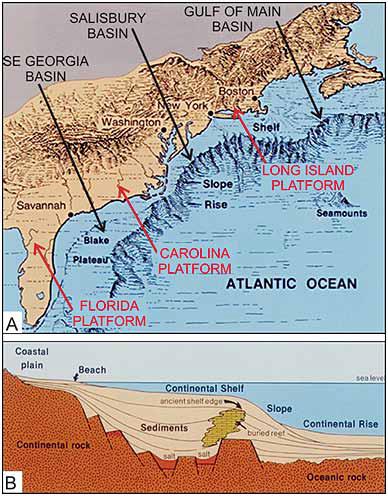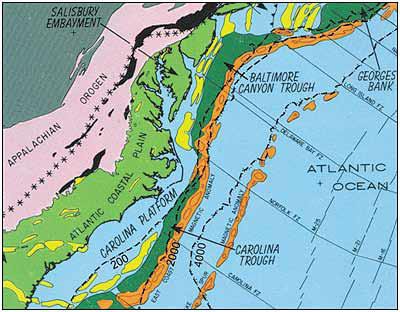All the geological ingredients may be there under the roiling waters off Cape Hatteras for the makings of one of the largest natural gas fields in America.
At least, that’s what geologists for Mobil Oil Corp. and seven other oil companies hoped in the 1980s when the companies leased 120,000 acres about 40 miles off the cape. Their scientists thought one in 10 wells drilled there would strike gas. Back then in the oil business, those were pretty good odds, good enough anyway to persuade the companies to commit at least $25 million – about $72 million today — to sink a few test wells. Public and political opposition eventually killed those plans, but the geology hasn’t changed.
Supporter Spotlight

On Offshore Energy
But even the best odds have a way of diminishing as the drill bit goes deeper and deeper, especially off the East Coast where no modern seismic surveying has been done that could better identify prospects. Fifty-one offshore wells were dug in the 1970s and ‘80s, mostly along the Northeast coast. Almost all were dry holes.
“But they were going after the Cretaceous,” said Stan Riggs over a plate of Mexican at Chico’s in downtown Greenville. “The Cretaceous is empty.”
Riggs, a researcher and professor emeritus at East Carolina University, is one of the most renowned marine geologists in the state. No one knows more about the complex geology of the N.C. coast.
He’s talking here about sediments laid down in a period of geologic history that started more than 145 million years ago as the super-continent Pangea was breaking apart and the Atlantic Ocean was forming. It ended 66 million years later with the disappearance of the dinosaurs. It was a time of great forests of ferns, cycads and conifers. Giant marine reptiles hunted ammonites, belemnites, other mollusks and fish, and pterosaurs soared in the air above.
But it wasn’t particularly a good time, at least on what is now the western margins of the Atlantic, for the ancient algae and bacteria that have powered an industrial world for more than a century now. For that, said Riggs, you need sediment and rocks from an earlier period.
Supporter Spotlight
“The Jurassic is where it’s at,” he said. “And the only place where you might get Jurassic within 50 miles of the North Carolina coast and that’s not in 12,000 feet of water is small area off Cape Hatteras.”
How Oil and Gas Form
They’re called fossil fuels for a reason. Oil and natural gas come from ancient organisms – tiny plants, algae and bacteria mainly – that were powered by the sun during various stages of Earth’s geologic history.
The deltas of big rivers like the Mississippi, the Amazon and the Niger are now the sites of some of the greatest oil and gas fields in the world because of all that sun-drenched organic matter that flowed down the rivers and settled in the deltas millions of year ago.
In that anoxic environment, the algae and plant matter in the sediment changed into a substance scientists call kerogen. And when the temperatures rose to at least 230 degrees the kerogen gradually changed into oil. Natural gas is oil that continues to cook – maturate in oil science lingo – at higher temperatures. The process from algae to crude or gas takes at least a million years.
Crude oil is a complex mixture of hydrocarbons – hydrogen, carbon and traces of other substances. Its texture varies, but it’s generally liquid. Natural gas is mainly made up of the chemical compound methane. It’s gaseous, or lighter than air.
Even after oil has formed in the rock, pressure continues to rise, squeezing the oil out or upwards through rocks that have more pores, or spaces, within them. Some of it eventually reaches the surface and seeps out naturally into land or water, but most of it eventually comes up against a layer of rock that it can’t move through. This impermeable rock forms a seal or trap, and slowly, very slowly, the oil builds up. As it does, it forms a reservoir.
These reservoir rocks are like fossilized sponges that usually hold both oil and natural gas within their pores. Gas, being less dense than oil, rises to the top of the reservoir. Then comes oil and then seawater, the most dense of the three, at the bottom.
The search for petroleum, then, is a search for those reservoirs, which can be massive. Some may be as large as the world’s greatest cities.
Jurassic Muck and Coral Reefs
As Pangea started to break up in the early Jurassic, about 200 million years ago, great chunks of granite separated from what is now North America, leaving behind huge holes along the new continent’s margins. Water — the nascent Atlantic – filled the gap being left by the breakup and sediment from the land started filling the holes.

On Offshore Energy
One of those big holes is the now called the Baltimore Canyon Trough that extends from the mouth of the Chesapeake Bay all the way to the tip of Long Island. Another hole, the Carolina Trough, runs south of there, from Cape Hatteras to about the middle of the South Carolina coast.
In those basins, covered by tens of thousands of feet of younger sediment, are salt domes and rocks formations, called shale, that are compressed organic muck from the Jurassic. Both almost certainly contain petroleum, Riggs notes. But they are in very deep water, 12,000 feet and more. Drilling at that depth is considered experimental even using the most modern methods.
Between the two holes off what is now the Outer Banks, there is high ground, a bit of Jurassic bedrock that didn’t make the long journey to Africa. It’s called the Norfolk Arch. It’s in relatively shallow water and 30-40 miles from shore. It’s where Mobil wanted to drill.
“They knew what they were looking for,” Riggs said. “That area is about the only place off our coast where you can drill into the Jurassic without getting into really deep water.”
The Jurassic was a good time for oil creation. Forget the dinosaurs that appear in the series of movies that have made the geologic period the only one most people know. Almost all of those reptiles appeared on the scene later, but “Cretaceous Park” doesn’t have same ring to it. The Jurassic was for plants and bacteria and algae.
The young Atlantic was calm and far from shore. The Appalachians were also young, and rivers brought its organic-rich sediment to the sea. Coral reefs grew abundantly. Think of the Florida Keys or the Bahamas. One such reef extended for 30 miles between two developing basins in the ocean floor, crossing a plateau between them. Mobil had targeted that high spot in the reef.
“In the Jurassic, we had this quiet, very shallow ocean that was full of limestone,” Riggs said. “It was a perfect setup.”
The sea rose by the late Cretaceous and over time the reef between the two basins got buried by sediment that is now 12,000 feet thick in places.
To Drill or Not to Drill

As promising as it looked to Mobil geologists, the old reef is currently untouchable by their successors. The proposed leasing plan for the Atlantic that the federal government released earlier this year includes a 50-mile buffer along the shoreline. That would put the reef off limits. Gov. Pat McCrory has urged that the buffer be moved 20 miles closer to shore to allow companies to drill into the old reef, but Congress would have to amend the leasing plan to make that happen.
If the buffer remains in place, Riggs thinks the oil companies will be reluctant to bid on leases in very deep water while oil and gas prices are depressed.
James Knapp isn’t so sure about that. He’s a former oil company geologist who is now a professor of earth and ocean sciences at the University of South Carolina. It all depends on the results of the seismic testing scheduled for late this year or next year.
“There may still be aspirations to pursue leases if the buffer remains in place,” he said. “They’re certainly interested to get out there and look. If you’re not replacing your reserve base, you’re going to go out of business.”







